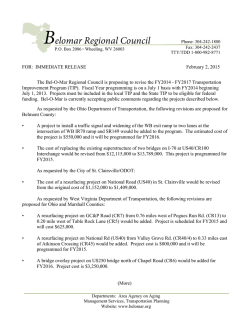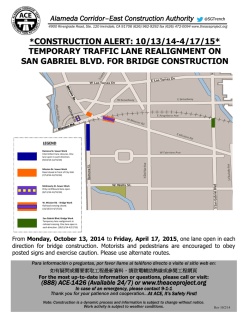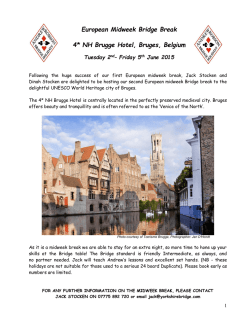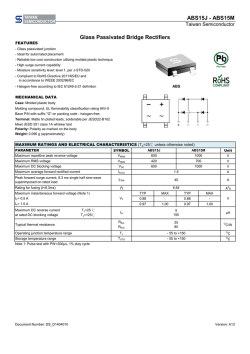
Download (899Kb)
Home Search Collections Journals About Contact us My IOPscience Bridging in contaminated transformer oil under DC and AC electric field This content has been downloaded from IOPscience. Please scroll down to see the full text. 2013 J. Phys.: Conf. Ser. 472 012007 (http://iopscience.iop.org/1742-6596/472/1/012007) View the table of contents for this issue, or go to the journal homepage for more Download details: IP Address: 152.78.191.139 This content was downloaded on 29/01/2015 at 15:56 Please note that terms and conditions apply. Dielectrics 2013 Journal of Physics: Conference Series 472 (2013) 012007 IOP Publishing doi:10.1088/1742-6596/472/1/012007 Bridging in contaminated transformer oil under DC and AC electric field. Shekhar Mahmud*1, George Chen1, Igor O. Golosnoy1, Gordon Wilson2 and Paul Jarman2 1 University of Southampton, Southampton, SO17 1BJ, UK 2 National Grid, UK *E-mail: [email protected] Abstract. There are two experimental set up have been established to investigate the bridging effect between two electrodes with different potentials under ac and dc voltages. This paper will explain the full details of the experimental setup and the results. These experiments carried out on pressboard particles under three different levels of ac and dc voltages. Several contamination levels have been investigated. Optical images of particle accumulation have been recorded along with associated conduction current measurement during experiments. At higher voltages the rate of bridge formation is increased along with an associated current increase. The major differences between ac and dc bridges are the shapes of the particle accumulation. The bridge formation rate for ac is slower than dc. 1. Introduction One of the key components in high voltage transmission and distribution systems are power transformers and their consistent operation is of utmost importance to energy utility companies and end users. However, transformer failures in the systems have gathered pace as more transformers are approaching or exceeding their designed lifetime. Almost 30% of total transformer failures are caused by insulation/oil contamination which has been revealed by recent analysis [1]. Therefore, it is essential to understand the failure mechanisms/processes so the proper measures can be taken to prevent transformer failure and this way we can save the huge cost caused by it in terms of asset loss and business interruption. Liquid dielectrics are used as insulation and cooling agent in almost all the high voltage power transformers. This petroleum based dielectric liquid is called “transformer oil”. One of the major disadvantages is the transformer oil can be easily contaminated [2, 3]. During packaging, shifting, storing the transformer oil can be contaminated. During the operation it contacts with metal, iron core and pressboard insulation inside a transformer. Contaminants such as metal filings or cellulosic residual can also be formed in the oil, especially for transformers with aged paper insulation. During normal operation non-uniform fields are present within the transformer. These contaminants tend to move towards high field regions due to dielectrophoresis (DEP) forces and could form a bridge over a period of time. The dielectrophoresis phenomenon first introduced by Phol [4] whereby a neutral body placed in an electric field becomes polarized and is equivalent to an electric dipole. One side of the dipole has an excess of positive charge and negative charge on the other. Under non-uniform electric field region, the forces acting on the two ends do not balance and the particles move towards either Content from this work may be used under the terms of the Creative Commons Attribution 3.0 licence. Any further distribution of this work must maintain attribution to the author(s) and the title of the work, journal citation and DOI. Published under licence by IOP Publishing Ltd 1 Dielectrics 2013 Journal of Physics: Conference Series 472 (2013) 012007 IOP Publishing doi:10.1088/1742-6596/472/1/012007 high or low field region. The bridge may potentially act as a conducting path between two different potentials within the transformer structure, leading to partial discharges or insulation failure. Many researchers have studies various aspects of bridging phenomenon in transformer oil, such as, conduction current, partial discharge, resistivity [5, 6, and 7] etc. Our previous studies were focused on the effect of particle size under DC electric field [8] and numerical simulation of the bridge in transformer oil [9]. This paper has particularly concentrated on the different mechanism of particle accumulation under the influence of DC and AC electric field. The aim of current work is to distinguish the particle accumulation process in contaminated transformer oil under the influence of AC and DC high electric field. Two different experiments have been set up to investigate the bridging effect between two electrodes with different potentials. The experimental setup and the results have been discussed in subsequent sections. These experiments have been carried out with pressboard particles under the influence of three different DC (2kV, 7.5kV and 15kV) and AC (10kV, 15kV and 20kV) voltages. There are several contamination levels of cellulose particles have been investigated ranging from 0.001% to 0.024% by weight. Optical microscopic images and conduction current of the bridge formation have been recorded for all the experiments. 2. Experiments 2.1. Sample tank We have used a glass built sample tank for all the experiments. The internal volume of the tank is 550 ml. There were two spherical electrodes with the diameter of 13mm placed in the middle of the cell and they were attached to side walls the of the test cell. The electrodes gap is adjustable via a screw and it was kept constant at 10 mm for all the experiments. 2.2. Preparations of samples A new pressboard which normally used in high voltage transformers was rubbed with metal files to produce the fiber like dust particles. The fibers were categorised in to different sizes using sieves. Four different sizes of particles were produced, less than 63 µm, 63-150 µm, 150-250 µm and 250-500 µm. The particles were separated by the fiber width rather than length. We have tested only 150-250 µm particles under the influence of AC electric field. The contamination levels for the particles were 0.001%, 0.002%, 0.003%, 0.006%, 0.008%, 0.016% and 0.024% by weight. We have cleaned the sample tank with soap solution in hot water and dried under hot air flow before starting any test with new particle size. The tank was first rinsed with some clean oil to repeat an experiment with same size particles and wiped thoroughly with cyclohexene. We have filled test cell with 300 ml of Gemini X type mineral transformer oil from Nynas to start a new experiment. The quantity of transformer oil was enough to submerge the electrodes completely. The contaminants of lowest level was then added to the oil. The sample tank was covered with cling film to protect from external dust and moisture and it remained covered for the whole period of experiment apart from adding the next level of contaminants. The sample tank was stirred for 2 minutes prior to every test on a magnetic stirrer which enable us to distribute the particles evenly thought the transformer oil. 2.3. Experimental Setup To record the optical images of the bridging, the test cell was placed under a digital camera mounted stereo microscope. We have positioned the microscope inside an aluminum box which acts as a Faraday Cage. The camera, Keithley Picoammeter 6485A and multimeter 2001 were controlled from a computer and the data were also saved on that computer. The high voltage supply were calibrated at the beginning of the experiments and an external circuitry used to monitor the voltage to ensure supply voltage is same for every test. Block diagrams of complete experimental setup is shown on figure 1 and 2. 2 Dielectrics 2013 Journal of Physics: Conference Series 472 (2013) 012007 Figure 1. Complete block experimental setup for DC test [7] diagram of IOP Publishing doi:10.1088/1742-6596/472/1/012007 Figure 2. Complete block experimental setup for AC test diagram of 2.4. Testing procedure One of the spherical electrodes was attached to the high voltage power supply and other electrode was connected to the ground via a Keithley picoammeter 6485 for DC and multimeter 2001 for AC to measure the conduction current through the gaps. Three different levels of DC (2kV, 7.5kV and 15kV) and AC (10kV, 15kV and 20kV) high voltages were applied to the samples. The experiments were conducted until a complete bridge was created or maximum of 25 minutes where there was no bridge. The digital camera was set to take images in a regular interval during the test to record the images of particle accumulation. The tests were carried out at room temperatures. The temperatures were kept within 3 degrees difference for all the DC experiments but the temperatures were not controlled for AC experiments. Each test was carried out three times for a particular voltage level to observe the repeatability. 3. Results and Discussion 3.1. Bridge formation with 0.001% contaminants The particles were moving back and forward between the electrodes as soon as 2kV DC was applied. They were charging from one electrode and discharging at the other. The pressboard fibers were started attaching on the electrode surfaces. Longer fibers was attached to the electrodes and then they elongated towards the other electrode. Small spherical particles started attaching themselves to the long fibers afterwards. A complete bridge continued to grow in this way. A very thin bridge formed for 2kV supply after 600s for on figure 3. Applied voltage of 7.5 kV initiated the particles movement more quickly. Within only 240s A thin bridge were formed. The bridge continued to grow thicker until 600s (figure 3). No change was observed after that. The completed bridge for the bigger particles was not as thick as for the smaller particles. The particles started to move fiercely after applying 15kV DC. A thin complete bridge was formed by 70s and it continued to thicken up to 300s. The bridges were thicker near the electrodes and thinner towards the middle. The particles were slowly moving after the 10kV AC supply turned on. They started to move towards the high gradient of electric field region and started attaching themselves to the electrodes slowly because positive of dielectrophoretic force. This process of attaching to the electrodes were going on equally to both electrodes. More particles were attached to the electrodes as time elapsed. These experiments were carried out on several contamination levels i.e. 0.001%, 0.002, 0.003, 0.006%, 0.008%, 0.016% and 0.024%. As the concentration increased the particle accumulations to the electrodes increased. But they never formed a complete bridge between the two electrodes. Our experimental result does not align with [6], in which bridging were observed with spherical and wrapped electrode system in moistened and pressboard fiber concentrated samples under AC electric 3 Dielectrics 2013 Journal of Physics: Conference Series 472 (2013) 012007 IOP Publishing doi:10.1088/1742-6596/472/1/012007 field under the influence of 6kV and 8 kV AC electric field for spherical and formed wire electrodes respectively. Figure 3. Optical microscopic images of bridging in contaminated transformer oil with 150-250 µm pressboard fiber, concentration level 0.001% under DC [8] Figure 4. Optical microscopic images of bridging in contaminated transformer oil with 150-250 µm pressboard fiber, concentration level 0.001% under AC 3.2. Bridge formation and conduction current with 0.003% contaminants for DC and 0.024% for AC The contaminants were started moving slowly between the electrodes after applying 2kV DC electric field. This movement of particles was due to charging and discharging. A complete thin bridge was observed after 180s. The bridge grew until 600s for as shown on figure 5. Different branches were made from one electrode to the other. It took only 10s to form a bridge after 7.5kV applied. The bridge was thickened until 300s, no change observed after that. The completed bridge for lower voltage was shallower than higher voltage. The movements of the particle were intensified after applying 15kV. A thin complete bridge was made within 5s, and thickened up to 60s. The movement of the particles were intensified with the applied voltage increased from 10kV, 15kV to 20kV AC. The particle accumulations towards the high electric field region were also increased with the applied voltage. This test with 0.024% contamination had the highest particle attachment to the electrodes. But no complete bridges were formed between the electrodes. Figure 5. Microscopic images of bridging in contaminated transformer oil, concentration level 0.003% under DC [8] Figure 6. Microscopic images of bridging in contaminated transformer oil, concentration level 0.024% under AC 4 Dielectrics 2013 Journal of Physics: Conference Series 472 (2013) 012007 IOP Publishing doi:10.1088/1742-6596/472/1/012007 Conduction currents with contamination levels of 0.001% to 0.004% and 0.001% to 0.024% shown in the figure 7 and 8 under the influence of 15kV DC and 15kV AC respectively. From the DC current plot we can observe that the current increased non-linearly with the increment of contamination level under a fixed voltage. When the contamination level linearly increased from 0.001% to 0.004%, the conduction current increased from 3, 6, 15, and 23 nano amp which means 2, 5 and 8 times with respect to lowest contamination level of 0.001%. There was no noticeable change exist in the AC conduction current. The contamination levels were tested from 0.001% up to 0.024% but as there was no complete bridge formed, the current also didn’t conducted through the particles. Figure 7. Conduction current with different contamination levels under the influence of 15kV DC electric field. Figure 8. Conduction current with different contamination levels under the influence of 15kV AC electric field. 3.3. Comparison between AC and DC conduction current The conduction currents of all the contamination levels are summarised in figure 9 for DC and figure 10 for AC. The maximum currents were plotted where the values almost steady. The DC conduction currents were almost linear with applied voltage of 7.5kV. Though some non-linearity features of the process can be clearly seen for 15kV but overall we can say that the current increased with the increment of contamination levels for DC case. Two different mechanism can contribute to the conduction, namely charging of separate particles by touching the electrodes together with their migration and formation of the conductive bridge. On the other hand, the conduction currents for AC were almost constant for all the concentration levels tested. There might be various reasons, there was no complete bridge formed between the electrodes, the particles were not charging because of alternating frequency quicker than charging time. It was also reported that the overall conductivity of the particles and the medium affects under low frequency but the overall permittivity affects by high frequency. Figure 9. Conduction current under DC. Figure 10. Conduction current under AC 5 Dielectrics 2013 Journal of Physics: Conference Series 472 (2013) 012007 IOP Publishing doi:10.1088/1742-6596/472/1/012007 4. Conclusion The major difference in particle accumulation under the influence of DC and AC voltage is the shape of the particles assembly. It can be concluded that at higher DC voltages, the rate of bridge formation is strongly increased along with an associated current increase. It takes longer time to accumulate the particles AC electric field compared to DC. The particles are strongly bonded, covered the half of the electrode surface and slow increase in the middle of the electrode for the AC case. A complete bridge between the two electrodes is always formed no matter how small is particle concentration level in transformer oil whereas for AC electric field there was never a case of full bridge formation between the electrodes even with the concentration level 24 time higher than the DC electric field. Future studies will include the experiments under DC biased AC electric field, effect of electrode shape and tests with insulated electrodes to comprehend the dynamics of particle accumulation in transformer oil. Acknowledgements Authors would like to thank National Grid and IET Power Academy for sponsoring the project. References [1] Sokolov, V. V., 1994. Experience with the refurbishment and life extension of large power transformers. Minutes of the sixty-first annual conference of doble clients, Sec. 6-4. [2] Rouse, T. O., 1998. Mineral insulating oil in transformers. Electrical Insulation Magazine, IEEE 14(3): 6-16. [3] Danikas, M.G., 1990, Breakdown of transformer oil. Electrical Insulation Magazine, IEEE. 6(5): p. 27-34. [4] Pohl H. A., 1951, The motion and precipitation of suspensoids in divergent electric fields. Journal of Applied Physics. 22(7): p. 869-871. [5] Chen G. and Zuber M. H., 2007, Pre-breakdown characteristics of contaminated power transformer oil, Electrical Insulation and Dielectric Phenomena, CEIDP 2007. Annual Report Conference on, 2007, pp. 659-662. [6] K. W. H. Moranda, H. M. Grzesiak, 2003, Dynamics of bridge creating in contaminated oil at AC voltage and analysis of accompanying partial discharges, XIII International Symposium on High Voltage Engineering, Netherlands. [7] J. G. M. Ossowski, H. Moronda and H. Moscicka-Grzesiak, 2003, Oil resistance at different phases of bridge mechanism development at direct voltage, XIII International Symposium on High Voltage Engineering, Netherlands. [8] Mahmud, S., Chen, G., Golosnoy, I. O., Wilson, G. and Jarman, P., 2012, Bridging phenomenon in contaminated transformer oil. Proceedings of 2012 International Conference on Condition Monitoring and Diagnosis. 2012 International Conference on Condition Monitoring and Diagnosis. Piscataway, US, Institute of Electrical and Electronics Engineers, 180-183. [9] Mahmud, S., Golosnoy, I. O., Chen, G., Wilson, G. and Jarman, P., 2012, Numerical simulations of bridging phenomena in contaminated transformer oil. Proceedings of 2012 IEEE Conference on Electrical Insulation and Dielectric Phenomena, Montreal, Canada, 14 - 17 Oct 2012.4pp, 383-386. 6
© Copyright 2026






